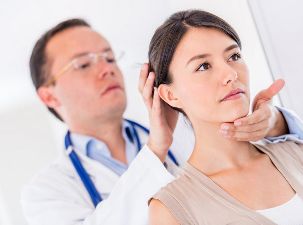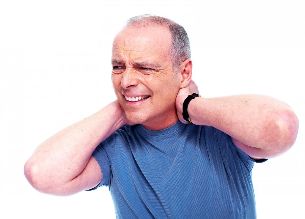Like other back diseases, grade 1 cervical osteochondrosis is characterized by pain. The nature of the pain can be called bearable, but this does not give a reason to leave the disease without seeking medical help and further treatment. Ignoring the symptoms of osteochondrosis, which is still in phase 1, can lead to worsening of the patient's condition and further development of the disease.
Self-medication is not recommended, only an experienced doctor can make a correct diagnosis, determine the cause of the symptoms of the disease and give clear recommendations for resolving osteochondrosis.
Causes of the disease
On the background of osteochondrosis of the 1st degree of the cervical spine, first of all, there are shooting pains, called lumbago. The pain syndrome occurs in the cervical region, in severe cases it spreads to the shoulders, arms and chest muscles. This occurs because the intervertebral discs tend to injure to a greater extent where the mobile part of the spine (cervical region) is connected to the less mobile, thoracic region.

The cervical part consists of 7 vertebrae. The first two support the skull, allowing the person to turn their head, tilt it, and lift it. The vertebrae are connected by joints and mobile ligaments, and the intervertebral discs, which consist of cartilaginous tissue, serve as a spacer between the vertebrae. Adjacent muscles are also designed to hold the spine in an upright position, if the muscular corset is well developed, the spine will be stable. As you can see, well-coordinated work of the vertebrae, intervertebral discs and muscles ensures healthy work of the spine. As soon as one link from this system starts to malfunction, disturbances in the overall work of the spine occur.
For what reasons can there be violations and the first symptoms of osteochondrosis appear:
- sedentary lifestyle;
- excessive physical activity;
- wrong sleeping position;
- a diet that does not provide the body with a sufficient amount of substances that strengthen the skeletal and muscular system;
- bad habits;
- stress;
- lack of adequate rest, fatigue;
- frequent hypothermia and colds.
If the muscles that support the spine in a stable position begin to age and lose tone closer to 50 years - this can be considered normal. But when the cervical vertebrae go through a process of deformation at the age of 20, it is worth paying attention and taking measures. Subject to preventive treatment, exercise, lead an active lifestyle and avoid inactive work of bent neck and back.
Symptoms
In order to list the main signs and symptoms that can accurately determine 1st degree cervical osteochondrosis, it is necessary to clarify the term itself.
Grade 1 osteochondrosis is the initial stage of the disease, which has so far been characterized only by compression of the cartilaginous tissue of the discs between the vertebrae. The spinal column is still in a stable position, but hook-shaped vertebral processes are already increasing. Dislocation of the disc is minimal, but its outer shell, which is made up of fibrous tissue, begins to disintegrate, which if left untreated can lead to the development of subsequent stages of osteochondrosis and even an intervertebral hernia.
Main symptoms of osteochondrosis of the cervical spine:
- The pain syndrome begins in the neck, spreading to the shoulder joints, shoulder blades, and chest muscles;
- tightening of nerve endings leads to the appearance of shooting pain in the neck, especially this condition is aggravated by uncomfortable posture in sleep, at night, after waking the patient keeps the neck in an unnatural position for a long time due to the impossibility of painless turning of the head;
- in the background of nerve root compression may appear cardiac syndrome - chest muscle pain, which a person mixes with heart pain (examination does not confirm the presence of cardiac pathologies);
- due to the syndrome of the spinal artery, the supply of the brain and spinal cord deteriorates, which causes headaches, visual disturbances in the form of "flies in front of the eyes", dizziness, pain in the occipital region;
- sleep disorders;
- worry.

The pain syndrome is accompanied by muscle spasms in the area of the affected spine. Grade 1 spinal osteochondrosis may not provide the above symptoms, it all depends on the body's sensitivity to pain and the general well-being of the patient.
With constant fatigue, inactive work and stress, any symptom of the disease is perceived more sharply. Therefore, the first sign of osteochondrosis - cracking neck pain, especially after physical exertion or hypothermia - should be a reason to visit a doctor.
Treatment and prevention
Therapy of 1st degree cervical osteochondrosis, above all, should be aimed at eliminating the pain syndrome and initiating active metabolic processes in the tissue of the intervertebral discs. It is also imperative to strengthen the muscular frame of the neck in order to keep the spine in a stable, strong position.
Drug therapy includes the following methods:
- painkillers, anti-inflammatory drugs;
- physiotherapy;
- massage;
- acupuncture;
- medical gymnastics;
- swimming
With the help of drug therapy it is necessary to alleviate pain and inflammation in the affected area, in this case the doctor can combine the appointment of oral anesthetic drugs with injections of vitamins, anti-inflammatory drugs. A good effect is given by the use of external means in the form of warming gels based on painkillers, as well as bee and snake venom.
In addition to drug therapy and physiotherapy, there can be therapeutic exercises that will help you gently stretch your spine, releasing pinched nerve roots and relieving neck pain. Subsequent preventative measures include a healthy, active lifestyle, exercise, good nutrition, and avoiding stress and hypothermia.























